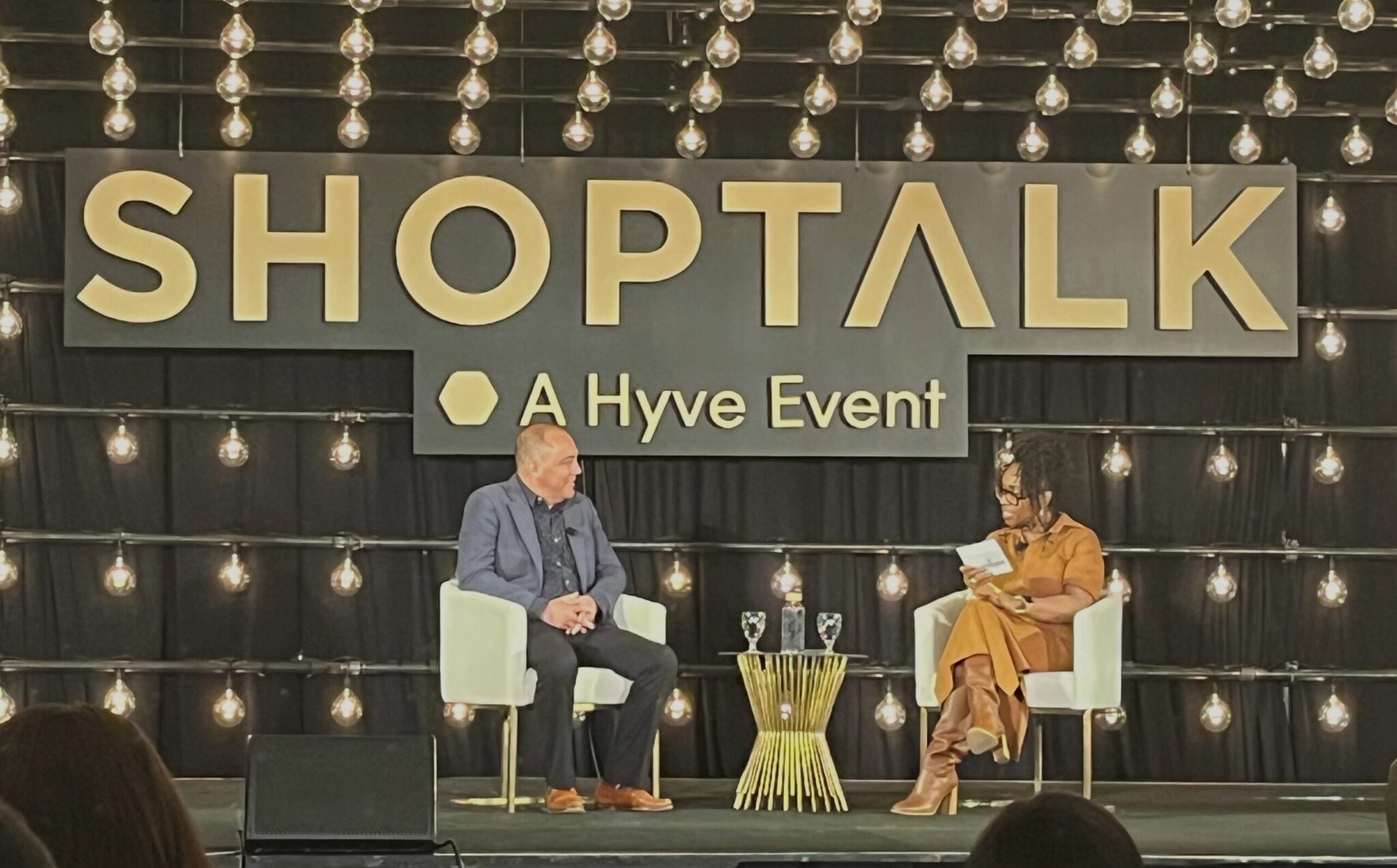

“If your brand went away tomorrow, would anybody care?” It’s a scarily relevant question that many retailers are likely asking themselves in the wake of recent high-profile closures. It’s also not a question to which many retailers could honestly answer “yes,” according to Matt Kaness, CEO, GoodwillFinds, who posed it during a session at Shoptalk last week.
“I think we could also say that half the brands in retail today can’t clearly say what they stand for, what their brand values are and what that means to the consumer,” added moderator Ndidi Oteh, Senior Managing Director and Head of the creative group Accenture Song Americas at Accenture.
How important is it to know the answer to these questions? Very, according to Oteh, who shared research showing that consumers today are more lonely than they have even been, and in the absence of fulfilling human connections they are turning to brands.
“Defining your brand values is the single most important action you can take as a brand to ensure that you’re relevant, not only today, but tomorrow,” she said. However, brand values go deeper than values-based statements around issues like DEI, sustainability and other of-the-moment social topics, she said: “Brand values are the essence of who you are as a company. It is what you stand for. It’s how consumers connect with you. I’m sure all of us have a brand that we love, and sometimes you can’t really explain why you love it. There’s just a reason that you love it; it makes you feel a certain way.”
Kaness has worked at many brands that fit that bill throughout his 20-year career in retail. Prior to his current role building an ecommerce offering for iconic charity Goodwill, Kaness held C-suite roles at Burton Snowboards, URBN, ModCloth and Walmart.
“I think a lot of brands right now are struggling as things are evolving because the world is shifting underneath them,” said Oteh. “They’re asking themselves, what does this mean for me? Do I say something externally? Do I shift who I am? Do I stay true to who I am? Those are questions that every single company should be asking themselves, because you’re always going to have to evolve, but you have to make sure that you do it your way and actually live what your values are.”
Kaness and Oteh explored how brands can do just that in these turbulent times.
1. Communication is Key
Many brands have a strong value foundation but haven’t done a very good job of sharing it with their customers and the larger world. In fact, even Kaness didn’t know the depth of Goodwill’s mission until he joined the organization. “I always thought of Goodwill as a cool place that you thrift shop and drop off donations,” he said. “But as I got involved in GoodwillFinds and traveled the country to immerse myself in their culture, [I came to realize] that what they were doing was bringing dignity to people who the economy has overlooked — individuals who were previously incarcerated, recovering from an addiction, living with a disability or previously homeless.”
Kaness realized that a key role as the head of Goodwill’s new ecommerce venture was to translate that powerful set of values to online consumers eager for secondhand goods. “The lens that I brought, as an outsider, was how the consumer was interacting with them and the massive amount of growth that was occurring online in the resale arena,” he explained. “We had to understand how to communicate this 100-year-old legacy and nonprofit values to a younger demographic online. There was a bit of a pivot — it wasn’t just the restating the mission of the charity; it was explaining how Goodwill has been pioneering circularity for 100 years and having an impact with consumers, communities and the planet. We had to shift the internal conversation to an external-facing conversation that was commercially relevant.”
Kaness had a similar experience when he joined Walmart through its acquisition of ModCloth (where he was CEO) in 2017. At the time, he also didn’t know much about the history of Walmart and was surprised to discover the sense of purpose that permeated that company. “You can see the founder’s fingerprints all over the internal culture in Bentonville, Ark. [where Walmart is headquartered],” he said. “They love their brand, but they never communicated [the brand vision] externally because Sam Walton despised the media and Wall Street and said, ‘If we take care of the customer, that will take care of the shareholders.’
“That, to me, is a pre-internet point of view,” Kaness added. “In this attention economy, you have to participate in the conversation or, as in the case of Walmart, others might fill in a negative narrative. Walmart was doing all this incredible work that nobody knew about, and so in that case, [the job] was to explain the importance of telling the story and being proud of it and having a commitment to it. I think we’ve all seen Walmart the last five years, how they’ve really pushed in the brand marketing funnel in a way that they hadn’t historically.”
2. Don’t be Afraid to Evolve
Some brands are founded on a clear set of principles and are able to maintain them, often because they find that their founding vision continues to align with consumer demand, as in the case of Patagonia. Sometimes, though, the world changes, consumer opinions shift and brand values need to be modified to account for those evolutions. This was the case at ModCloth, which was one of the first fashion brands to sell plus-size options alongside its other sizes.
“[Founder] Susan Koger had pioneered inclusive fashion in the country before most of the big brands co-opted those words and the marketing and the messaging,” said Kaness. “But when I got there, the market was confused as to whether ModCloth was a plus-size brand or not.”
Not being a customer himself (given that ModCloth was a women’s brand), Kaness approached the business through the viewpoint of his then-teenaged daughter. “ModCloth was the world that I wanted my daughter to live in, and it came to me that what we were really doing was trying to make women of all shapes and sizes feel included,” he said. “But then it hit me — if you’re telling half your customer base that we’re identifying you based on the word ‘plus,’ how does that feel?”
The company retired the term “plus” from its marketing and instead leaned into the inclusivity angle, and “sales just took off,” said Kaness.
3. Have a Narrow Focus, but Broad Appeal
Identifying a brand’s core set of values is an inherently limiting action, but it’s necessary: a brand that tries to stand for everything will eventually stand for nothing. This was put to the test during Kaness’ time at URBN, when analysts frequently questioned why the company’s Anthropologie brand didn’t expand into men’s and kids like competitors such as J.Crew and Banana Republic had.
“Our founder’s response was, ‘You don’t understand what we’re doing. Our Anthro customer doesn’t want to be reminded of her husband and her children when she’s shopping in our store,’” recounted Kaness. “You have to narrowly focus on and know your values, but having a narrow focus means saying ‘no’ to a lot of things,” he said.
At the same time, those brand values need to be present everywhere and in everything: “From the consumer’s perspective, your brand values are a promise to them, and you have to make sure that every touch point reinforces that promise.”
4. Be Honest and Authentic
Sometimes the pursuit of a brand’s values can lead to practices that make consumers unhappy. Higher prices are one common example. At Shoptalk, the owner of an independent thrift shop raised this question at the session, saying that with the rise of online resale her team is frequently now accused of “gate-keeping” the better products in the store so they can be sold online at a higher price.
Kaness, who also has faced this criticism as he builds GoodwillFinds.com, advised the shop owner to avoid obfuscation and lean into the truth: “[At GoodwillFinds] we’re a charity,” he said. “Our mission is to make as much money off donations so that local charities can provide more support to their communities, and so it’s my fiduciary responsibility to maximize the price and margin I can get for any donation that is given to us. My advice to you, if you’re a nonprofit, is lean into communicating that the reason you’re doing it is just to have more proceeds to support your mission and the community.”
Essentially, “To thine own self be true,” or put into modern parlance, define what you stand for and then own it, proudly. This tactic also has been central to Gap’s recent turnaround, which has centered on returning that brand to its roots.
Boiled down, Kaness’ ultimate advice is to “follow the customer,” he said, adding “I’m constantly surprised by the customer, and with all the brands that I’ve worked, one of the throughlines is we always prided ourselves as customer experts.”
Editor’s Note: In an interesting development, particularly considering Kaness’ question that kicked off this story, it appears that GoodwillFinds has ceased operations. It’s no secret that online resale on the lower end of the pricepoint spectrum is challenging to run profitability, and GoodwillFinds faced many of the same challenges as its peers while also contending with the complicated nuances of being a nonprofit and the unique structure of the Goodwill organization. The company has not yet responded to Retail TouchPoints’ request for details, but we’ll share more when we know it.

